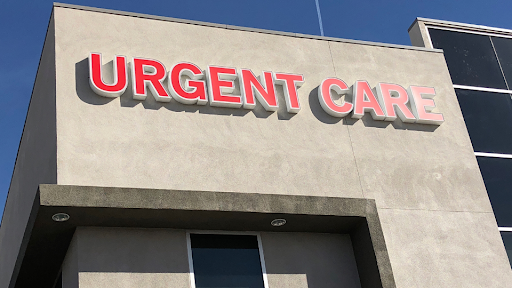Can I Take Zepbound a Day Early?
Key TakeawaysZepbound is a once-weekly injectable medication for weight management and obstructive sleep apnea (OSA) linked to obesity.Taking Zepbound a day early is [...]
Read More
Medically reviewed by Abhijit Bhattacharyya | MD, PhD, MBA, Tufts University School of Medicine - Miami, Florida on June 21st, 2025.
When faced with a medical issue, knowing where to seek help can be a daunting task. With various options available, such as primary care physicians, emergency rooms, and urgent care facilities, it’s essential to understand the best choice for your situation. This article aims to clarify when to visit urgent care, what services they provide, and how telehealth options like Doctronic.ai can assist in your decision-making process.
 Understanding Urgent Care
Understanding Urgent CareUrgent care centers are designed to provide immediate care for non-life-threatening conditions that require prompt attention. They serve as a middle ground between primary care and emergency rooms, offering extended hours and shorter wait times than traditional hospitals. This makes them an invaluable resource for individuals who need quick medical assistance but do not require the extensive services of a full emergency department. Many urgent care facilities are equipped with diagnostic tools such as X-ray machines and lab testing capabilities, allowing for a more comprehensive evaluation of a patient's condition on-site.
Urgent care facilities can handle a variety of medical issues. Common conditions treated include:
Minor fractures
Sprains and strains
Infections (such as urinary tract infections or strep throat)
Allergic reactions
Minor cuts and lacerations
Cold and flu symptoms
While urgent care centers can address many issues, they are not equipped for severe conditions like heart attacks, strokes, or major trauma. Understanding the scope of services can help you decide if urgent care is the right option. Additionally, many urgent care centers offer preventative services such as vaccinations and physical exams, making them a convenient choice for families looking to maintain their health without the need for a primary care visit.
Deciding to visit urgent care often comes down to the severity and nature of the medical issue. If symptoms appear suddenly and require immediate attention but are not life-threatening, urgent care is typically the best choice. For example, if someone experiences a mild asthma attack or a high fever, urgent care can provide timely treatment without the long wait associated with emergency rooms. Furthermore, urgent care centers often have a more relaxed atmosphere, which can be particularly beneficial for children or anxious patients. Unlike the often chaotic environment of an emergency room, urgent care facilities aim to provide a more streamlined experience, allowing patients to receive care in a calm and efficient manner.
While both urgent care centers and emergency rooms offer critical medical services, they cater to different needs. Understanding these differences can help you make an informed decision.
One of the most significant differences between urgent care and emergency rooms is cost. Urgent care visits tend to be more affordable, often resulting in lower copays and out-of-pocket expenses. Additionally, urgent care centers usually have shorter wait times, making them a more convenient option for non-emergency situations. Many urgent care facilities also accept a wide range of insurance plans, which can further alleviate financial concerns for patients seeking immediate care. Furthermore, some urgent care centers offer transparent pricing for self-pay patients, allowing individuals without insurance to know upfront what their visit will cost.
Urgent care facilities often operate outside of regular business hours, providing services in the evenings and on weekends. This flexibility can be invaluable for those who cannot visit their primary care physician during standard office hours. In contrast, emergency rooms are open 24/7, but the wait times can be significantly longer, especially during peak hours. It's also important to note that while urgent care centers are designed to handle a variety of medical issues, they may not have the same level of resources as emergency rooms for more severe conditions. For instance, if a patient is experiencing chest pain or severe trauma, the emergency room is equipped with advanced diagnostic tools and specialists available to provide immediate, life-saving interventions.
Identifying when to seek urgent care can be challenging. Here are some signs that indicate an urgent care visit may be appropriate:
If symptoms last longer than expected or worsen over time, it may be time to seek medical attention. For instance, a cough that lingers for more than a week or a fever that doesn’t respond to over-the-counter medication warrants a visit to urgent care. Additionally, if you experience unusual fatigue, shortness of breath, or persistent headaches, these could be signs of underlying issues that require professional evaluation. Ignoring these symptoms can lead to complications, so it’s always better to err on the side of caution and consult a healthcare provider.
For minor injuries such as sprains, strains, or small fractures, urgent care is an excellent option. These facilities are equipped to handle such cases, providing necessary treatments like X-rays and splinting without the lengthy wait typically found in emergency rooms. Furthermore, urgent care centers often have on-site labs for quick testing, which can be crucial for diagnosing conditions like infections or other acute issues. If you find yourself dealing with cuts that require stitches or burns that need treatment, urgent care can offer the immediate assistance you need to promote healing and prevent infection.
Respiratory problems, such as difficulty breathing, wheezing, or severe allergies, can escalate quickly and require prompt attention. If you notice that your asthma symptoms are worsening or if you experience sudden chest tightness, visiting an urgent care center can provide you with the necessary medications and treatments to alleviate your condition. These facilities typically have the resources to administer nebulizer treatments and other interventions that can stabilize your breathing and ensure your safety.
Gastrointestinal issues, such as severe abdominal pain, persistent vomiting, or diarrhea that lasts more than a day, may also necessitate a visit to urgent care. These symptoms can be indicative of infections, food poisoning, or other serious conditions that require medical evaluation. Urgent care centers can perform tests to determine the cause of your distress and provide treatments to help you recover more quickly, ensuring that you receive the appropriate care without the long wait associated with emergency rooms.
In today's digital age, telehealth services are becoming increasingly popular. Platforms like Doctronic.ai offer virtual consultations, allowing patients to discuss their symptoms with healthcare professionals from the comfort of their homes. This shift towards digital healthcare not only enhances patient experience but also streamlines the overall healthcare delivery system, making it more efficient and responsive to patient needs.
Telehealth provides several advantages, including:
Convenience: Access medical advice without the need to travel.
Time-saving: Reduce wait times and avoid crowded waiting rooms.
Accessibility: Reach healthcare providers in remote areas or for those with mobility issues.
Using telehealth services can help determine whether an urgent care visit is necessary, providing guidance based on your symptoms. Moreover, telehealth can also facilitate better management of chronic conditions, as it allows for regular check-ins with healthcare providers, ensuring that patients stay on track with their treatment plans. This continuous monitoring can lead to improved health outcomes and a greater sense of empowerment for patients managing long-term health issues.
Telehealth is particularly useful for non-urgent concerns, such as follow-up appointments, medication refills, or minor ailments that do not require physical examination. If a healthcare provider determines that an in-person visit is needed, they can guide you to the nearest urgent care facility. Additionally, telehealth can be an excellent resource for mental health services, offering therapy and counseling sessions that can be conducted via video calls. This flexibility allows individuals to seek help without the stigma or barriers that sometimes accompany traditional in-person visits, making mental health care more accessible to a wider audience.
When visiting an urgent care center, being prepared can enhance your experience and ensure you receive the care you need efficiently.
To make the most of your visit, consider bringing the following items:
Your insurance card and identification
A list of current medications and allergies
Any relevant medical history or previous treatment records
Having this information readily available can help healthcare providers make informed decisions about your care. Additionally, if you have any recent lab results or imaging studies, bringing those along can provide valuable context for your current condition. This proactive approach not only streamlines the process but also allows the medical staff to better understand your health background, which can lead to more accurate diagnoses and tailored treatment options.
Upon arrival at an urgent care center, you will typically check in and complete any necessary paperwork. After a brief wait, a healthcare professional will assess your condition. Depending on the diagnosis, they may perform tests, provide treatment, or refer you to a specialist if needed. It's important to note that urgent care centers are equipped to handle a wide range of non-life-threatening conditions, from minor injuries and infections to more complex issues like respiratory problems. The staff is trained to prioritize cases based on urgency, so while you may see others being attended to first, rest assured that your needs will be addressed as soon as possible.
During your visit, don’t hesitate to ask questions or express any concerns you may have about your symptoms or treatment options. Open communication is key to ensuring you feel comfortable and informed throughout the process. Many urgent care facilities also offer follow-up care instructions, which can be incredibly helpful as you continue your recovery at home. Understanding the next steps, whether it's medication management or lifestyle adjustments, can significantly impact your healing journey.
 Common Misconceptions About Urgent Care
Common Misconceptions About Urgent CareDespite the growing popularity of urgent care centers, several misconceptions persist. Addressing these can help clarify their role in the healthcare system.
Many people mistakenly believe that urgent care is only for emergencies. In reality, it caters to a wide range of non-life-threatening conditions that require prompt attention. This makes it an excellent option for many common health issues.
Not all urgent care facilities are created equal. Some may offer specialized services, such as pediatrics or occupational health, while others may focus on general care. Researching local options can help ensure you choose a facility that meets your specific needs.
Deciding whether to go to urgent care can be a complex decision influenced by various factors, including the nature of your symptoms, the urgency of your situation, and your healthcare preferences. Understanding the role of urgent care, its benefits, and when to seek help can empower you to make the right choice.
For non-urgent concerns, telehealth services like Doctronic.ai can provide valuable guidance, helping you determine if an in-person visit is necessary. By being informed and prepared, you can navigate your healthcare options with confidence, ensuring you receive the care you need when you need it.
When you're unsure if urgent care is the right step, Doctronic is here to guide you. As the #1 AI Doctor, we offer free AI doctor visits that provide you with a diagnosis in seconds, which you can take to any doctor for further help and treatment. Our telehealth video visits are not only affordable but also available 24/7 across all 50 states. Join over 10 million people who have experienced our revolutionary direct-to-patient care. Skip the line. Talk to an AI Doctor Now, for free.
Key TakeawaysZepbound is a once-weekly injectable medication for weight management and obstructive sleep apnea (OSA) linked to obesity.Taking Zepbound a day early is [...]
Read MoreKey TakeawaysZepbound is an FDA-approved medication for chronic weight management in adults with obesity or overweight, and for moderate to severe obstructive sleep apnea [...]
Read MoreKey TakeawaysZepbound is a once-weekly injectable medication that supports weight loss by activating hormone pathways regulating appetite and digestion.After the first dose, [...]
Read More